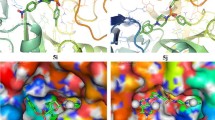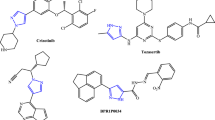Abstract
Newcastle disease virus is the most devastating virus in poultry industry. It can eradicate the entire poultry flocks once infected. This study is aimed to investigate the antiviral efficacy of novel phosphorylated analogues of the drug abacavir (ABC) against Newcastle disease virus (NDV). About 16 analogues of ABC were designed and docking was performed against fusion protein of NDV. Three compounds were identified and selected for synthesis and biological evaluation based on binding affinity and docking scores. The compounds were synthesized and characterized by IR, 1H, 13C, 31P and CHN analysis and mass spectra. These compounds were tested for antiviral efficacy against NDV-infected DF-1 cells. Compound ABC-1 had shown potent antiviral activity as evidenced by significant reduction in plaque units and cytopathic effect. Therefore, ABC-1 was selected to test for NDV-infected chicken survival rate. Effective dose50 concentrations were determined for ABC-1. Antioxidant enzyme levels in brain, liver and lung tissues were estimated. Superoxide dismutase and catalase were significantly raised and lipid peroxidation and HA titer levels were decreased upon treatment with 2 mg/kg body weight ABC-1. Histopathological modifications were also restored in the ABC-1-treated group. These findings demonstrated ABC-1 as a potential antiviral agent against NDV in chicken.










Similar content being viewed by others
References
Alexander, D. J. (2001). Newcastle disease. British Poultry Science, 42, 5–22.
Mayo, M. A. (2002). A summary of taxonomic changes recently approved by ICTV. Archives of Virology, 147, 1655–1663.
Steward, M., Vipond, I. B., Millar, N. S., & Emmerson, P. T. (1993). RNA editing in Newcastle disease virus. Journal of General Virology, 74, 2539–2547.
Brown, C., King, D. J., & Seal, B. S. (1999). Pathogenesis of Newcastle disease in chickens experimentally infected with viruses of different virulence. Veterinary Pathology, 36, 125–132.
Faletto, M. B., Miller, W. H., Garvey, E. P., St Clair, M. H., Daluge, S. M., & Good, S. S. (1997). Unique intracellular activation of the potent anti-human immunodeficiency virus agent 1592U89. Antimicrobial Agents and Chemotherapy, 41, 1099–1107.
Mocarski, E. S., Shonk, T., Griffiths, P. D., & Pass, R. F. (2003). Cytomegaloviruses. In D. M. Knipe et al. (Eds.), Fields virology (pp. 1960–2014). Philadelphia: Lippincott Williams and Wilkins.
Hitchcock, M. J. M. (1993). In vitro antiviral activity of didanosine compound with that of other dideoxynucleoside analogues against laboratory strains and clinical isolates of Human Immunodeficiency virus. Clinical Infections Diseases, 16, 516–521.
Daluge, S. M., Good, S. S., & Faletto, M. B. (1997). A novel carbocyclic nucleoside analog with potent, selective antihuman immunodeficiency virus activity. Antimicrobial Agents and Chemotherapy, 41, 1082–1093.
Geetha, S., Emmanuel, F. M., & Rodger, D. M. (2010). Abacavir/Lamividine combination in the treatment of HIV: a review. Therapeutics and Clinical Risk Management, 6, 83–94.
Kesharwani, R. K., Srivastava, V., Singh, P., Rizvi, S. I., Adeppa, K., & Misra, K. (2015). A novel approach for overcoming drug resistance in breast cancer chemotherapy by targeting new synthetic curcumin analogues against aldehyde dehydrogenase 1 (ALDH1A1) and glycogen synthase kinase-3 β (GSK-3β). Applied Biochemistry and Biotechnology, 176, 1996–2017.
Balzarini, J., Stefano, A., Alshaimaa, H. A., Susan, M. D., Carlo-Federico, P., & Chris, M. (2004). Improved antiviral activity of the aryloxymethoxyalaninyl phosphoramidate (APA) prodrug of abacavir (ABC) is due to the formation of markedly increased carbovir 50-triphosphate metabolite levels. FEBS Letters, 573, 38–44.
Youcef, M., Jan, B., & Christopher, M. (2009). Aryloxy phosphoramidate triesters: a technology for delivering monophosphorylated nucleosides and sugars into cells. ChemMedChem, 4, 1779–1791.
Rao, V. K., Reddy, S. S., Krishna, S. B., Reddy, S. C., Reddy, P. N., Reddy, C. M. T., Raju, C. N., & Ghosh, S. K. (2011). Design, synthesis and anti colon cancer activity evaluation of phosphorylated derivatives of Lamivudine (3TC). Letters in Drug Design & Discovery, 8, 59–64.
Chandra Sekhar, K., Janardhan, A., Nanda Kumar, Y., Narasimha, G., Naga Raju, C., & Ghosh, S. K. (2014). Amino acid esters substituted phosphorylated emtricitabine and didanosine derivatives as antiviral and anticancer agents. Applied Biochemistry and Biotechnology, 173, 1303–1318.
Friesner, R. A., Banks, J. L., Murphy, R. B., Halgren, T. A., Klicic, J. J., Mainz, D. T., Repasky, M. P., Knoll, E. H., Shelley, M., Perry, J. K., Shaw, D. E., Francis, P., & Shenkin, P. S. (2004). Glide: a new approach for rapid, accurate docking and scoring. 1. Method and assessment of docking accuracy. Journal of Medicinal Chemistry, 47, 1739–1749.
Bernstein, F. C., Koetzle, T. F., Williams, G. J. B., Meyer, E. F., Jr., Brice, M. D., Rodgers, J. R., Kennard, O., Shimanouchi, T., & Tasumi, M. (1978). The protein data bank: a computer-based archival file for macromolecular structures. Archives of Biochemistry and Biophysics, 185, 584–591.
Chen, L., Gorman, J. J., McKimm-Breschkin, J., Lawrence, L. J., Tulloch, P. A., Smith, B. J., Colman, P. M., & Lawrence, M. C. (2001). The structure of the fusion glycoprotein of Newcastle disease virus suggests a novel paradigm for the molecular mechanism of membrane fusion. Structure, 9, 255–266.
Scudiero, D. A., Shoemaker, R. H., Paull, K. D., Monks, A., Tierney, S., Nofziger, T. H., Currens, M. J., Seniff, D., & Boyd, M. R. (1988). Evaluation of a soluble tetrazolium/formazan assay for cell growth and drug sensitivity in culture using human and other tumor cell lines. Cancer Research, 48, 4827–4833.
Reed, L. J., & Muench, H. (1928). A simple method of estimating fifty percent endpoints. American Journal of Hygiene, 27, 493–497.
Shin-Ru, S., Tzu-Yun, C., Gadarla, R. R., Sung-Nain, T., Hsiun-Ling, C., Wen-Fang, T., Ming-sian, W., Jiann-Yih, Y., Yu-Sheng, C., John, T. A. H., Hsing-Pang, H., & Jim-Tong, H. (2010). Pyrazole compound BPR1P0034 with poten and selective anti-influenza virus activity. Journal of Biomedical Science, 17, 13–22.
Sardjono, B. (1989). Plaque assay of Newcastle disease virus. Bul Penelit Kesehat, 17, 207–215.
Miller, L. C., & Tainter, M. L. (1944). Estimation of LD50 and its error by means of log-probit graph paper. Proceedings of the Society for Experimental Biology and Medicine, 57, 261–269.
Cunningham, C.H. (1966). Quantitative methods. In A laboratory guide in virology, 5th ed. Minnesota: Burgess publishing company.
Hiroshi, O., Ohishi, N., & Yagi, K. (1979). Assay of lipid peroxides in animal tissues by thiobarbituric acid reaction. Analytical Biochemistry, 95, 351–358.
Misra, H. P., & Fridovich, I. (1972). The role of superoxide anion in the auto-oxidation of epinephrine and a simple assay for superoxide dismutase. Journal of Biological Chemistry, 247, 3170–3175.
Aebi, H., & Packer, L. (1984). Catalase in vitro. Methods in Enzymology, 105, 121–126.
Slaoui, M., & Fiette, L. (2011). Histopathology procedures: from tissue sampling to histopathological evaluation. Methods in Molecular Biology, 691, 69–82.
Lowry, O. H., Rosenbrough, N., Farr, A. L., & Randall, R. J. (1951). Protein measurement with the Folin phenol reagent. Journal of Biological Chemistry, 193, 265–275.
Thomas, L. C. (1974). Interpretation of the infrared spectra of organophosphorus compounds. London: Hyden & Son Ltd.
Cristopher, M. C., Harris, S. A., Daluge, M., Gudmundsson, K. S., McLean, E. W., Burnette, T. C., Marr, H., Hazen, R., Condreay, L. D., Johnson, L., De Clercq, E., & Balzarini, J. (2005). Application of phosphoramidate pronucleotide technology to abacavir leads to a significant enhancement of antiviral potency. Journal of Medicinal Chemistry, 48, 3504–3515.
Rao, V. K., Sanapalli, S. R., Raveendra, K. B., Hema Kumar, K., Ghosh, S. K., & NagaRaju, C. (2011). Synthesis and cytotoxicity evaluation of phosphorylated derivatives of ribavirin. Journal of the Korean Chemical Society, 55, 952–959.
Thangaraj, S., Sundaraj, R., Dhanapal, D., Jebamalai, R. A., Selvaraj, A., & Velliyur, K. G. (2011). Molecular docking and QSAR studies on plant derived bioactive compounds as potent inhibitors of DEK oncoprotein. Asian Journal of Pharmaceutical and Clinical Research, 4, 67–71.
Anna, M. A., Marco, T., & Antonino, L. A. (2009). QSAR study investigating the potential anti-HIV-1 effect of some acyclovir and Ganciclovir analogs. Arkivoc, 8, 85–94.
Sriram, D., Perumal, Y., Naga, S. M., & Vivek, S. (2006). Abacavir prodrugs: microwave-assisted synthesis and their evaluation of anti-HIV activities. Bioorganic & Medicinal Chemistry Letters, 16, 2127–2129.
Yingjie, S., Shengqing, Y., Ding, N., Chunchun, M., Songshu, M., Shilei, Z., Yuan, Z., Xusheng, Q., Lei, T., Hongjun, C., Cuiping, S., & Chan, D. (2013). Autophagy benefits the replication of Newcastle disease virus in chicken cells and tissues. Journal of Virology, 88, 525–537.
Boriskin, Y. S., Leneva, I. A., Pécheur, E. I., & Polyak, S. J. (2008). Arbidol: a broad-spectrum antiviral compound that blocks viral fusion. Current Medicinal Chemistry, 15, 997–1005.
Kin, K. L., Nam, N. C., Fang, Y., Jun, D., Li, L., Zhiwei, C., Kong, H. S., Hong, L. C., Kwok, Y. Y., & Richard, Y. T. K. (2015). Identification of novel fusion inhibitors of influenza a virus by chemical genetics. Journal of Virology, 90, 2690–2701.
Ravendra, K. B., Valasani, K. R., Yellapu, N. K., Kishore, P., Kadiam, V. S., Matcha, B., Lokanatha, V., & Naga Raju, C. (2012). Identification of substituted [3, 2-a] pyrimidines as selective antiviral agents: molecular modeling study. Antiviral Research, 95, 118–127.
Tong, O., Xiao-Ying, L., Li-Bo, H., Feng-Jian, Z., & Qi-Ya, Z. (2014). Development of an Ussuri catfish Pseudobagrus ussuriensis skin cell line displaying differential cytopathic effects to three aquatic animal viruses. Virus Research, 189, 56–62.
Sharma, C. S., Nema, R. K., Sharma, V. K., & Meyyanathan, S. N. (2009). Synthesis and antiviral activity of some novel diazabicyclo compounds. International Journal of ChemTech Research, 1, 764–768.
Elizondo, R. G., Elizabeth, L. C. S., Denis, R. M., Edgar, M. G., Cristina, R. P., & Laura, M. T. (2012). In vitro characterization of the antiviral activity of fucoidan from Cladosiphon okamuranus against Newcastle Disease Virus. Virology Journal, 9, 307–315.
Balzarini, J., Friederike, H. M., Erik, D. C., & Chris, M. (2001). Antiviral activity of cyclosaligenyl prodrugs of acyclovir, carbovir and abacavir. Antiviral Chemistry & Chemotherapy, 12, 301–306.
Proctor, H. P. (1989) Free radicals and human disease: CRC handbook of free radicals and antioxidants. 1: pp. 209–221.
Venkata Subbaiah, K. C., Raniprameela, D., Visweswari, G., Rajendra, W., & Lokanatha, V. (2011). Perturbations in the antioxidant metabolism during Newcastle disease virus (NDV) infection in chicken. Naturwissenschaften, 98, 1019–1026.
Khalid, R. (2007). Studies on free radicals, antioxidants, and co-factors. Clinical Interventions in Aging, 2, 219–236.
Acknowledgments
Dr. Lokanatha Valluru is highly thankful to SERB (No. SR/SO/AS-021/2013 dt.29.11.2013), New Delhi, for providing financial assistance in the form of research grant. We are also thankful to Palamur Bioscience, Mahaboobnagar, for providing the cell culture facility and Dr. D. Raniprameela, S.V. Veterinary University, Tirupati, for providing the NDV inoculum.
Author information
Authors and Affiliations
Corresponding author
Ethics declarations
Conflict of Interest
The authors declare that they have no conflict of interest.
Rights and permissions
About this article
Cite this article
K. A., S., Venkata Subbaiah, K.C., Lavanya, R. et al. Design, Synthesis and Biological Evaluation of Novel Phosphorylated Abacavir Derivatives as Antiviral Agents Against Newcastle Disease Virus Infection in Chicken. Appl Biochem Biotechnol 180, 361–381 (2016). https://doi.org/10.1007/s12010-016-2104-x
Received:
Accepted:
Published:
Issue Date:
DOI: https://doi.org/10.1007/s12010-016-2104-x




